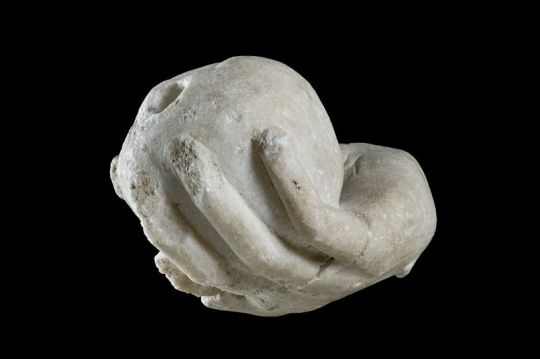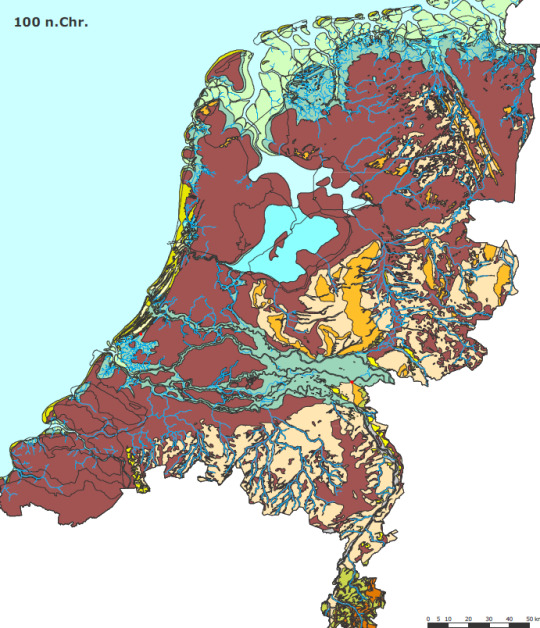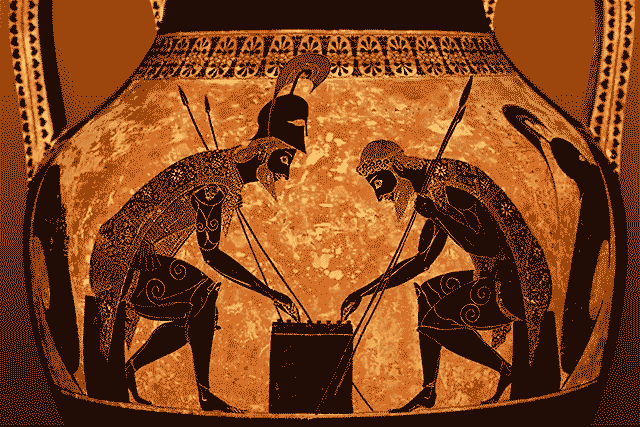#6th century BCE
Explore tagged Tumblr posts
Text

Limestone statues of Cypriot women
* Vouni
* 5th century BCE / 6th century BCE
* Medelhavsmuseet, Stockholm
Stockholm, November 2023
#Cyprus#Vouni#5th century BCE#6th century BCE#palace#temple#ancient#art#statue#limestone#clothing#jewelry#detail#Medelhavsmuseet#my photo
233 notes
·
View notes
Text

Terracotta vase in the form of a swan (6th century BCE, Greek, Corinthian).
Image and text information courtesy The Met.
167 notes
·
View notes
Text

Bronze helmet of Corinthian type, Greek, late 6th Century BCE
From the Met Museum
#bronze helmet#helmet#corinthian#greek#ancient greek#ancient greece#6th century bce#bce#ancient#history#armour
54 notes
·
View notes
Text

“Adad-guppi was the mother of the last Neo-Babylonian king Nabonidus (556– 539 BCE) and most details about her are known from a pseudo-autobiographical text, which was most probably composed after her death. The text, written in the first person, informs us about the long life of Adad-guppi. The text emphasizes her special relationship to the moon good Sin, to whom Adad-guppi dedicated her life:
When in my dreams his hands were set (upon me), Sîn the king of gods spoke to me thus: “The return of the gods is because of you. I will place the dwelling in Harran in the hands of Nabonidus your son. He will construct Ehulhul and make perfect its work.”(Svärd 2019: 56 )
Earlier, the text recounted that the city of Harran was destroyed in 610, the destruction that made it necessary to reconstruct or at least to renovate the temple Ehulhul. It is not the king himself who receives the dream about his divine mission, but the dream is revealed to his mother who takes the role of a mediator between the god and her son. The reason for stressing the role of his mother might be that Nabonidus seemingly had no right to the throne through his paternal line, so he focused on his wise mother who had closer ties to his predecessor on the throne. Although Adad-guppi was not the daughter of one of the earlier kings, she claims to have had such a close relationship to the former kings that they elevated her to the status of a daughter. She repaid this treatment by taking care of the offerings for the kings after their deaths.
According to her autobiography, Adad-guppi played an important role as an advisor and supporter of her son, the king Nabonidus. There was not much reason for her son to exaggerate the role of his mother after her death, so her assertion is likely correct.”
Fink Sebastian, "Invisible Mesopotamian royal women?", in: The Routledge companion to women and monarchy in the ancient mediterranean world
#adad-guppi#queens#history#women in history#mesopotamia#6th century BCE#women's history#historyedit#quotes#historyblr#historicwomendaily#ancient world#antiquity
40 notes
·
View notes
Photo
Acropolis Museum: Statue of a rider. "The Rampin Rider"

The Rampin Rider, (c. 550 BC) is an equestrian statue from the Archaic Period of Ancient Greece.
Courtesy & currently located at the Acropolis Museum, Athens. Photo taken by Roccuz
#Rampin Rider#6th century BCE#Acropolis#athlete#sports#ancient#Greek#marble#statue#equestrian#archaic#art#hairstyle#Acropolis Museum#Athens
228 notes
·
View notes
Text

Etruscan Bronze Helmet in the Shape of a Wolf’s Head 6th-5th centuries BCE.
#Etruscan Bronze Helmet in the Shape of a Wolf’s Head#6th-5th centuries BCE#Wolf's Head Helmet#Head of a Boar#bronze#bronze helmet#bronze sculpture#ancient artifacts#archeology#archeolgst#history#history news#ancient history#ancient culture#ancient civilizations#etruscan history#etruscan art
4K notes
·
View notes
Text
got asked what my favorite century is as a joke but now i'm going to be thinking about this for a while. i don't think it's the fifth century bce actually.
#surprisingly the 6th and 3rd centuries bce are strong contenders#1st and 19th centuries ce are always good ones#mine
21 notes
·
View notes
Text

Rhodian jug
* 7th / 6th century BCE
* British Museum
London, July 2022
164 notes
·
View notes
Text
Food serving vessel (dui), early 6th century BCE
Eastern Zhou dynasty, (770–256 BCE), China
Bronze
H. 8 in. (20.3 cm); Diam. 10 5/8 in. (27 cm)
Collection of the Metropolitan Museum of Art

Food serving vessel (dui)
China
early 6th century BCE
#Chinese#art#art history#bronze#6th century bce#eastern zhou dynasty#zhou dynasty#the met#the metropolitan museum of art
264 notes
·
View notes
Text
i often think about the inscription of nora, in sardinia, where the ancient land of tarshish, a place also talked about in the jewish bible, is talked about; it is the only testimony we have of tarshish in the western mediterranean.
scholars have tried to locate tarshish for centuries; they presumed is somewhere in the western mediterranean, but there's no conclusion. there's a theory i like tho.
because tarshish sounds similar to tartessos. in the nora inscription it says that it was the people from tarshish who sailed there and founded nora. and in pausanias he recalls how a group of iberians sailed to nora and founded the city, the oldest one in sardinia. we're talking about 9th century BCE or earlier btw. and if tarshish is tartessos, that means they were integrated into the mediterranean cultural sphere long before we thought they were, being involved with affairs at the other side of the sea.
#biblical studies are so fascinating to me cause you get references to people and events lost in time#from a time where we have very little texts very little archaeological remains#just the bible i guess#that's how we can also identify the sea peoples as the mycenaean greeks#idk i love that time period#everything between the 13/12th and 7/6th centuries BCE
2 notes
·
View notes
Text

Hand of a Kore holding a fruit, Greek, 6th Century BCE
From the Acropolis Museum
#kore#hand#sculpture#statue#art#greek#ancient greek#ancient greece#6th century bce#bce#ancient#fruit
64 notes
·
View notes
Text

Frisia around the 6th century CE. Made by Fryske Akademy after Heidinga.



Landscape maps of the Netherlands in the Northern Iron Age show that Frisia was mainly a coastal landscape with wetlands (peatland, moor, bog, etc.) inland and only got wetter over time. 1) 500 BCE 2) 100 CE 3) 800 CE Made by Rijksdienst voor Cultureel Erfgoed.
Brown means peat-wetland. Yellow spots at the shores indicate dunes or ridges, the most inhabitable land, as the orange spots in the illustration at the top of this post also indicate.
#frisia#northern iron age#map#netherlands#wadden#zeeland#zuid-holland#noord-holland#north sea#friesland#groningen#utrecht#gelderland#6th century#5th century BCE#1st century#8th century#island#germany#denmark
1 note
·
View note
Text
“What is the difference between Orphic and Homeric Hymns?”
The Orphic and Homeric hymns are both significant in the context of ancient Greek literature and religion, but they differ in origin, purpose, and style.
1. Origin and Tradition:
- Homeric Hymns: These hymns are attributed to Homer, though they were likely composed by various poets in the 7th and 6th centuries BCE. They are part of the broader tradition of epic poetry and are generally seen as a way to honor the gods through narrative and invocation.
- Orphic Hymns: These hymns are tied to the Orphic tradition, which is associated with the mythical figure Orpheus. The Orphic hymns date from later periods (around the 3rd century BCE to the 3rd century CE) and reflect a more esoteric and philosophical approach to religion.
2. Content and Themes:
- Homeric Hymns: Each hymn typically praises a specific deity, recounting myths or stories related to their attributes, powers, and deeds. They often serve a liturgical purpose, meant to invoke the favour of the gods.
- Orphic Hymns: These often incorporate themes of mysticism, cosmology, and the soul's journey. They focus more on personal religious experience and metaphysical concepts, such as the nature of the divine and the afterlife.
3. Style and Structure:
- Homeric Hymns: They generally follow a narrative structure and employ traditional epic techniques, such as invocation and epithets. The language is grand and formal.
- Orphic Hymns: While also poetic, these hymns tend to use a more lyrical and mystical language, emphasizing philosophical ideas. The structure can be less consistent than that of the Homeric hymns.
While both types of hymns celebrate the gods, the Homeric hymns are more concerned with storytelling and invocation in a traditional epic style, whereas the Orphic hymns delve into mystical and philosophical themes, reflecting a different aspect of religious belief.
If I missed anything or messed anything up please let me know, I am up to hear about your opinions / knowledge on this too ^^
#hellenic pagan#hellenic polytheism#hellenic polythiest#hellenism#hellenistic#homeric hymns#orphic hymn#paganism
865 notes
·
View notes
Text

An ancient Greek kylix showing a baby sitting in his pottychair and calling to his mother. ca. 480 BCE, the Royal Museums of Art and History, Brussels. And a 6th Century BCE potty found in the Athenian Agora. Agora Museum, Athens
More: https://thetravelbible.com/top-artifacts-from-ancient-greece/
2K notes
·
View notes
Text

The first beauty queen in Iraq was Jewish.
In 1946, Renée Rebecca Dangoor was crowned Miss Baghdad, and she became Miss Iraq the following year, making her the first and only Jewish woman to hold these titles.
Renée was born to a Jewish Baghdadi family in December 1925. Her father, Moshe Dangoor, was the son of Ezra Dangoor, a prominent rabbi in Iraq.
Iraqi Jews are one of the oldest and most historically significant Jewish communities, tracing their roots back to the Babylonian exile in the 6th century BCE. By 1948, Iraq was home to approximately 150,000 Jews. Today, nearly all have been forced to leave the country because of their Jewish identity.
#israel#secular-jew#jewish#judaism#israeli#jerusalem#diaspora#secular jew#secularjew#islam#iraq#Bagdad#baghdad#Sephardi#Sephardic#sephardism#mizrahi#indigenous#miss iraq#beauty queen
573 notes
·
View notes
Photo
youtube
Attic Black-Figure: Exekias, amphora with Ajax and Achilles playing a game, September 29, 2012
A conversation between Dr. Beth Harris and Dr. Steven Zucker in front of an Attic black figure amphora by Exekias (potter and painter), archaic period, c. 540-530 B.C.E., 61.1 cm high, found Vulci (Gregorian Etruscan Museum, Vatican). Created by Beth Harris and Steven Zucker. Smarthistory

Homeric mind is ingenuity, practical intelligence. There is no Rodin-like deep thinking, no mathematical or philosophical speculation. Odysseus thinks with his hands.
- Camille Paglia
#Gregorian Etruscan Museum#vatican museums#smarthistory#Exekias#mythology#Greek#Ajax#Achilles#Trojan War#Attic#figure#black figure ware#archaism#Vulci#art#art history#ceramic#terracotta#earthenware#Youtube#6th century bce
290 notes
·
View notes